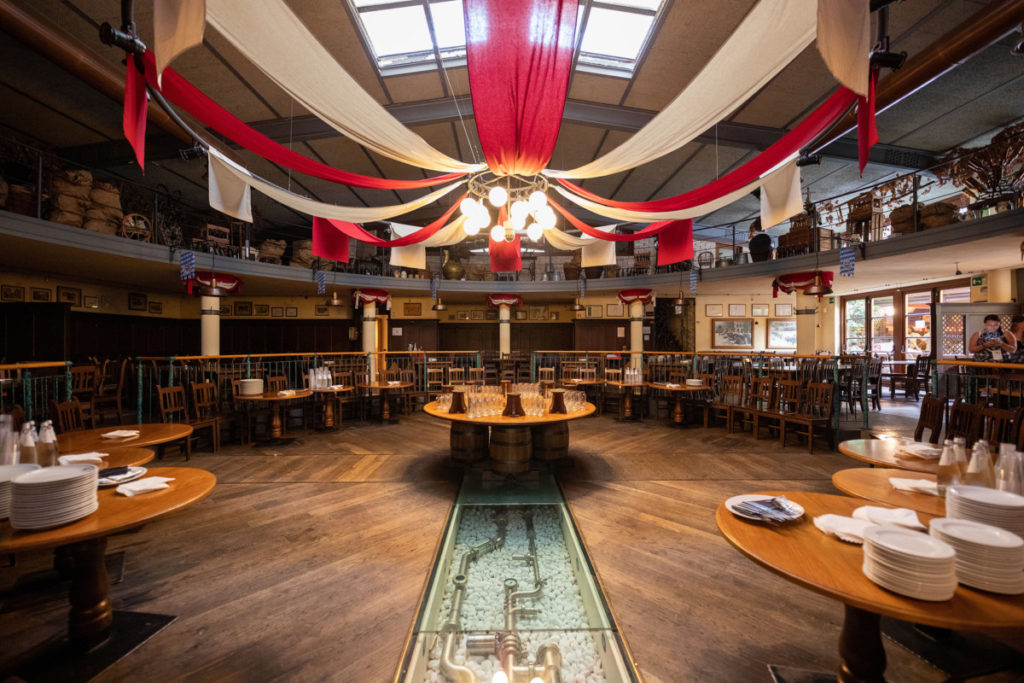Back in June, I attended Traverse, a conference dedicated to content creators and the blogging industry. Each year it takes place at a different destination, and this year it took place in Trento, Italy. The event has established itself as the most important gathering for content creators, and after attending last year’s edition in Rotterdam, I decided to attend again. One of the highlights of this concept is that it doesn’t have the usual ‘conference’ format, but rather a festival-like atmosphere with an extensive pre-conference programme and social activities, taking place during the week, with an educational conference being held on the weekend.
I purchased an early bird ticket, and until the very last moment, I was hesitant whether I should go because this period turned out to be a very busy time of the year. After many considerations, I decided to go and was very glad that I did because it exposed me to useful educational content, and I got to visit a new MICE destination. Unfortunately, I had to skip the pre-conference activities and could come only for the conference on the weekend, arriving Friday night and leaving Monday morning. The good thing about this event was that the overall programme provided an immersive experience of the city beyond the conference venue, so I still got to see enough of it to get a rounded destination experience.
I haven’t attended events in Italy before, and after having a chat with my colleague Laura Notarbartolo from Italian Special Occasions DMC and meeting Stefania Rosa from Riva del Garda Fierecongressi at IMEX, who both gave me useful tips about the city, I decided to give it a try. A big plus for me was the option to travel by train from Heidelberg and until the very last moment, I hadn’t made any travel arrangements. I booked the Grand Hotel Trento also at the last moment. The hotel is just opposite the train station and was close to the conference venues. Trento is designed so that it’s easy to get around on foot, an aspect that I highly value when travelling for business.
The opening night was at a unique venue called The Galleries. Built in the 1970s to speed up the traffic flow around the city, this construction is now used as an event space for all kinds of events, and with the mountains in the background, it was the perfect backdrop for the opening night. I loved this venue a lot!
Bright and early the following day, the conference officially opened at the Teatro Sociale. The opening speech took place at the main concert hall, which is spectacular, and there were workshops in the breakout rooms upstairs. What I found particularity interesting was how they set up the conference space together with the coffee break and exhibition space. These last two weren’t at the Teatro Sociale, but instead, a dedicated pavilion was erected in the central Town Square.

Between conference sessions, there was time to get out and grab a snack or a coffee at the pavilion, and by doing so stroll through the city. It was a great way to stretch the legs, see more of Trento and fuel oneself on the strong Italian coffee. Thinking with my event planner hat on, the pavilion certainly seemed to be an additional logistical challenge and added financial investment to build, but it was an original and functional space to accommodate the needs of that size of event (approximately 400 attendees).
Lunches on the weekend were yet another highlight. Each attendee received a voucher for lunch and was allocated to a restaurant. Attendees had lunch in smaller groups in restaurants around Trento to taste the best of the local cuisine—a great opportunity to encourage attendees to network with each other during the seated lunch! When it comes to food, Italy always scores extra points!
The Saturday night venue was a particular highlight because the first Traverse Awards also took place then, and it required a memorable venue. So that aspect was covered as well with Mart— the Museum of Modern and Contemporary Art of Trento and Rovereto. The absolute highlight of this venue is the large glass and steel dome above the central access piazza to the Museum, designed by the Ticino-born architect, Mario Botta. The roof construction is designed to maintain a ‘constant dialogue with the light,’ creating an overall soft light at the venue and when it gets darker, visitors can see the stars and the moon. The roof has the same measures as the Pantheon in Rome—it covers an area of 1,300 square metres, is 25 metres high and has a diameter of 40 metres.

The Mart is outside of Trento, so we had an organised coach transfer from the city taking approximately 30 minutes.
The closing night was at a more casual place, held in Birreria Pedavena, a bar and a restaurant with a dedicated event space. It was a beer and pizza night, with pizzas being served regularly and put on tables and with beer on tap. Again, it was a good choice of venue, and the overall venue choices were excellent by being so diverse, convenient and central.

Educational sessions
Now let’s get to the content part, which was another key element of this event. The first session that I attended was about ‘Presenting to camera’ with Sabrina Chiki. Because presenting to camera doesn’t come naturally to everyone, the good news is that it’s a skill that can be learned by practising. First of all, it’s important to ‘own your confidence’, and writing scripts can make one better at presenting. Sabrina then advised that when speaking to camera, it’s important to look at the camera, speak to the audience and ‘imagine their responses.’ It’s recommended to use gestures such as nodding and even imagining an exchange of eye contact, assuming how the audience is reacting. It’s also advised to lead the conversation by asking questions, and respond as the audience would do if they were in the room. Each individual needs to find out how they feel comfortable speaking to the camera.

Afterwards, I attended a workshop about ‘Writing as a skill’ with Steve Keenan. In the travel blogging community, the online content is increasing, and the pressure to create more content, using more channels and platforms is very high. Therefore, it was highly refreshing to attend this session, confirming that the written word will always be a powerful approach for conveying a message.
Steve shared that the reader needs something inspiring in the first two paragraphs (about 200 words long) about what happened, and it should also be personal. In the blogger community, there is a challenge between SEO vs an inspiring piece of content, which often conflicts with writing styles. ‘As you start writing with enthusiasm, keep what you started with as opposed to moving to being purely informative, and it’s possible to keep the balance between individual vs informative approach.’ It’s also important to distinguish between ‘it’s about me’ vs being the expert, a preferred approach in travel writing. The writer should look at how to solve the problems of travellers; for example, sharing information regarding how to get to a destination. Details add to the story, so include as many details as possible—don’t just say ‘I did this and that’ because it doesn’t add value for the readers. And lastly, the ending can make or break the writing piece. Therefore, it’s necessary to start and finish with the same piece of information.
Afterwards, I attended a second session about writing called ‘The writing still matters’ with Max Hartshorne. He suggested that writers should get right to the point, and the hardest part is to do the ‘story arch’—something has to happen and then change, for example, a perception of a destination. He then spoke about trying to use all the senses in the writing piece—taste, smell, touch. It’s also important to stick to one tense. If the trip is over, then don’t use the present tense. Use simple language and write conversationally. It’s also important to be specific and not attempt to cover everything—it is particularly important to include details and facts. By using facts, the writing can augment the story. The writer should strive to ‘tell the new’ and take a fresh perspective; for example, by writing about familiar subjects from a new angle. It’s also important to quote people. Include emotions, and don’t use the word ‘amazing’—you can do better than that! For example, replace amazing with divine, splendid, extraordinary, glorious, smashing, and the list goes on. Look for synonyms. And lastly, ‘make your story about their trip, how it will look and feel, it’s not about you. Writing is like a muscle; the more you write, the better you get.’
Another interesting presentation was about religious tourism, ‘Writing about spiritual and religious sites for the $8 billion travel market’ by Cate Michelle. I decided to listen to a topic I know very little about, and it didn’t disappoint. Religious sites are also used as event venues, so I was curious to learn about the pitfalls for content creators writing about spiritual and religious sites. A religious tourist is defined as someone who is travelling exclusively for a pilgrimage, for a spiritual purpose, such as healing, to fulfil a vow or promise or to pray in a particular place. The most common tourism is a mix of spiritual and cultural interest, or purely for cultural interest. When shared on social media, content creators should write responsibly about these sites, particularly if the sites are outside of the writer’s own locations and traditions. These tips also apply when writing about cultures that are not our own, and it is important to be more sensible with information that goes out on social media.
Here are some more interesting facts and figures about the religion travel market, which is huge. In 2003 it was an $8 billion industry, now it’s estimated at $18 billion. Religious travel includes pilgrimages, mission work/ trips, retreats, visits to religious sites, religious conferences and camping. The biggest markets include India, Saudi Arabia, Israel/ Palestine and Italy. The religious tourism market is not as vulnerable to recessions and currency changes, and people tend to ‘take the trip anyway’ because it has a deeper meaning.
The closing panel was back at the concert hall at Teatro Sociale, and it had an engaging format where four panellists were brought together to highlight the key topics discussed at the conference. That was a great opportunity for everyone to hear about the other sessions that ran in parallel during the two days and receive a complete picture of the entire conference programme and also the industry as a whole.
The two days provided great food for thought to reflect upon and new content strategies, which I’m already successfully implementing. It was highlighted at the closing panel that travel blogging is not just an industry, but a community, and with this comes responsibility for more inclusivity, diversity, ethics and morals. Bloggers, destinations and governments should have a conversation, and work collaboratively to bring a set of standards for more ethics and morals, educate and explain. There are no barriers to entry, but bloggers need a high standard of ethics and morality. Over the years, the community hasn’t just grown, it blossomed, so it’s necessary to continue sharing and supporting each other, and don’t forget why you started blogging in the first place.
That was it for Traverse 2019, with an overall highly positive experience in terms of networking, educational content and visiting Trento. I know that next year, the event will be moving to a new destination, but I wish it would stay one more year in Trento so I could come a bit earlier next time and explore the region further.




No Comments